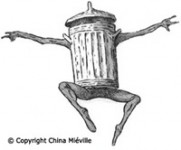Alabaster by Caitlin R. Kiernan is a book of short stories about Dancy Flammarion (what a terrific name!), an albino girl who’s been tapped by some mystical/alien/supernatural forces to fight for the good guys – but this is no fairy tale or super-hero yarn. She’s a young girl who has lost her family, and wanders the world with a big knife in her duffel bag, waiting for the ‘angel’ to tell her where to go next, which monster she has to kill. Meanwhile, she doesn’t know where her next meal is coming from and may have to walk that 100 miles to the next town.
Kiernan is incredible. Her descriptions are spare on physical details and heavy in emotional weight. She sketches a separate universe in convincing broad stroke simply for the sake of hinting at (but by no means explaining) why Dancy has been tapped by these angels for the ugly job she’s had thrust upon her. I read Alabaster in May, and loved her writing so much I put some of Kiernan’s other novels on hold.
Silk is a frightening novel of strange deaths and creepy things hiding in the shadows – oh yeah, and spiders. I feel like the book needs a warning label: DANGER: Reading this book may cause you to become arachnophobic, and arachnophobes may require hospitalization.
Horror really isn’t my genre any longer, but Kiernan’s writing is so fantastic I loved it anyway. I think – for me at least – the haunting comes from her writing, not from the plot. I was hooked to the end, and had figured out just enough of what was going on (this lady does not spoon-feed her readers, no sir) that I had to stick around and find out the rest. And while the plot was basic, Kiernan’s treatment of it was a perfect blend of detail and broad strokes.
Phrases like this one describing Savannah, Georgia:
the old city laid out wide and flat where the Savannah River runs finally into the patient, hungry sea. The end of Sherman’s March, and this swampy gem was spared the Yankee torches, saved by gracious women and their soiree seductions, and in 1864 the whole city made a grand Christmas gift to Abraham Lincoln.
reach out and smack you without interfering with the pace of the story. Me, of course, I stop and read it over a few times, letting it dance around my head and make pictures, teasing me with the idea that writing phrases like that is a goal I could live with.
I admit, most of the evocative phrases (that come immediately to mind) deal with darkness and what hides inside – and doesn’t always stay safely hidden – so her books are not recommended for those who can’t watch scary movies for fear of nightmares. I imagine her stories would have the same effect – as much for what she refuses to describe as for what she paints so tangibly for you.
I think I liked the short stories better because they were more about the language than the plot. Without the need to carry the story for more than a few thousand words, the focus is on making each word do the job of three, and the result (in Kiernan’s capable hands) is a joy to behold. I think that Chabon was the last writer whose dexterity I felt so impressed by, though they have little else in common. I also enjoyed getting to know Dancy over the course of those stories, and cared about her more than I did the characters in Silk, though I liked them well enough.
Alabaster is sometimes considered Young Adult fiction since Dancy is somewhere around 15, but Silk is definitely adult fiction (due to the inclusion of some ugly drug use and one sex scene that’s more than just hinted at – and I guess some [idiots] would say because that sex scene is between two women).
I found Kiernan via Neil Gaiman (what, you’re surprised? He has a real thing for the horror genre done well), but I think she’s my favorite recommendation so far. It’s funny, but many of the books/writers that Gaiman recommends… well, they really aren’t my thing. And I feel guilty for not loving them. Which is ridiculous, of course. I don’t even love everything he’s done (least fave – Anansi Boys), why would I love every single book he’s ever liked? And of course, he’s let me off the hook – he also thinks it’s silly to expect everyone to like the same things all the time (he said so many times in his blog, no instance of which can I find right this minute so as to link to it). However, many of his other recommendations (artists and musicians, mostly) I’ve adored (Lisa Snellings! – I must own a poppet).
Footnote: as I was writing this entry, I went looking for a copy of Alabaster I could call my own (having read a library copy) and was dismayed to see it out of print, with the least expensive copy being a used hardback for $60. However, my anger soon turned to joy when I found a $5 eBook copy and had it on my PC & my iPod in less than 10 minutes – and that while having to choose formats, download an app and figure out how to work it. And if my computer crashes or whatever, I can always download it again. I’ll never give up my paper books, but who can argue with that?

